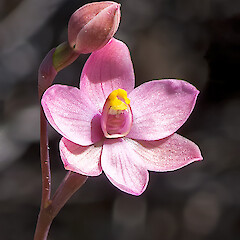Thelymitra carnea
Common name
pink sun orchid, early sun orchid
Synonyms
Thelymitra carnea var. imberbis (Hook.f.) Rupp et Hatch, Thelymitra imberbis Hook.f.
Family
Orchidaceae
Flora category
Vascular – Native
Endemic taxon
Yes
Endemic genus
No
Endemic family
No
Structural class
Orchids
NVS code
The National Vegetation Survey (NVS) Databank is a physical archive and electronic databank containing records of over 94,000 vegetation survey plots - including data from over 19,000 permanent plots. NVS maintains a standard set of species code abbreviations that correspond to standard scientific plant names from the Ngä Tipu o Aotearoa - New Zealand Plants database.
THECAR
Chromosome number
2n = 62
Current conservation status
The conservation status of all known New Zealand vascular plant taxa at the rank of species and below were reassessed in 2017 using the New Zealand Threat Classification System (NZTCS) – more information about this can be found on the NZTCS website. This report includes a statistical summary and brief notes on changes since 2012 and replaces all previous NZTCS lists for vascular plants.
Please note, threat classifications are often suggested by authors when publications fall between NZTCS assessment periods – an interim threat classification status has not been assessed by the NZTCS panel.
- Conservation status of New Zealand indigenous vascular plants, 2017 . 2018. Peter J. de Lange, Jeremy R. Rolfe, John W. Barkla, Shannel P. Courtney, Paul D. Champion, Leon R. Perrie, Sarah M. Beadel, Kerry A. Ford, Ilse Breitwieser, Ines Schönberger, Rowan Hindmarsh-Walls, Peter B. Heenan and Kate Ladley. Department of Conservation. Source: NZTCS and licensed by DOC for reuse under the Creative Commons Attribution 4.0 International licence.
2017 | Not Threatened | Qualifiers: SO
Previous conservation statuses
2012 | Not Threatened
2009 | Not Threatened
2004 | Not Threatened
Distribution
Indigenous. New Zealand: North Island (mainly northern to about Taupo, local around the southern North Island, apparently absent in between), South Island (confined to the northern third, mainly in the west).
Habitat
Coastal to montane (up to 700 m a.s.l.). Mostly at low elevations and favouring open clay pans, consolidated sand hollows, and geothermal ground. Sometimes on the margins of peat bogs. Most often in gumland scrub or other semi-permanent shrubland habitats where it is especially abundant after fire.
Detailed description
Terrestrial, tuberous, glabrous, late winter to early summer-green perennial herb, either solitary or in well-spaced groups. Plants mostly reddish-green, at flower 100–300 mm tall. Leaf solitary, wiry, distinctly flexuose, fleshy to subcoriaceous, 80–160 × 2.5–3.0 mm, dark green to reddish green, terete or semi-terete and shallowly channelled, apex often twisted, subacute, often frayed. Inflorescence a 1–8-flowered raceme. Flowers widely spaced, 8–14 mm diameter, segments to 8 × 4 mm, mostly pink, rarely cream or pale lemon yellow with the sepals darker coloured than the petals, without spots or stripes, scarcely opening or not, if opening only slightly spreading. Sepals and petals alike, broadly oblong. Labellum very slightly smaller. Column to 4 mm long, cream to pale pink or dark pink; column arms obliquely erect, more or less ovate, thick, fleshy, margins crenate or toothed, rarely with a few small spheroidal glands, otherwise without further ornamentation or cilia; post-anther lobe almost as high as anther, erect, margins fleshy, unevenly thickened to very slightly cucullate, weakly notched, bright yellow. Anther not prominent.
Manaaki Whenua Online Interactive Key
Similar taxa
Not likely to be confused with anyother indigenous species. This species is readily identified by the reddish colour of the stem and leaf, and the slender, zig-zagged (flexuose) terete to semi-terete leaf (usually with a twisted and distinctly frayed apex). The widely spaced mostly pink flowers which scarcely open, are also distinctive. While the small pink grading to yellow, scarcely hooded and notched column, and flattened, toothed column arms lacking cilia are also unusual in New Zealand Thelymitra.
Flowering
August–October
Flower colours
Cream, Red/Pink
Fruiting
September–January
Propagation technique
Difficult - should not not be removed from the wild.
Threats
Not Threatened. However, it has declined from large parts of its range through habitat loss to taller forest or through urban development. Still abundant in the far north but if trends continue it may qualify in the not too distant future for a worse conservation status.
Etymology
thelymitra: Woman’s hat
carnea: From the Latin carnus ‘flesh’, meaning flesh-coloured
Taxonomic notes
Thelymitra carnea is based on an Australian type. Australian plants tend to be slightly larger than New Zealand forms and often have cream or reddish coloured flowers. Some people regard the New Zealand plant as endemic and use the name T. imberbis Hook.f. for it.
Attribution
Fact Sheet prepared for NZPCN by Peter J. de Lange (14 April 2007). Description adapted from Moore Edgar (1970).
References and further reading
Moore LB, Edgar E. 1970. Flora of New Zealand, Volume II. Indigenous Tracheophyta: Monocotyledones except Gramineae. Government Printer, Wellington, NZ. 354 p.
Rolfe JR, de Lange PJ. 2010. Illustrated guide to New Zealand sun orchids, Thelymitra (Orchidaceae). Jeremy Rolfe, Wellington, NZ. 57 p.
NZPCN Fact Sheet citation
Please cite as: de Lange, P.J. (Year at time of access): Thelymitra carnea Fact Sheet (content continuously updated). New Zealand Plant Conservation Network. https://www.nzpcn.org.nz/flora/species/thelymitra-carnea/ (Date website was queried)









